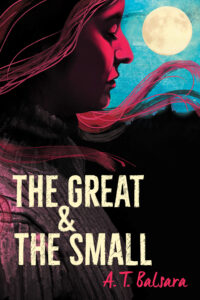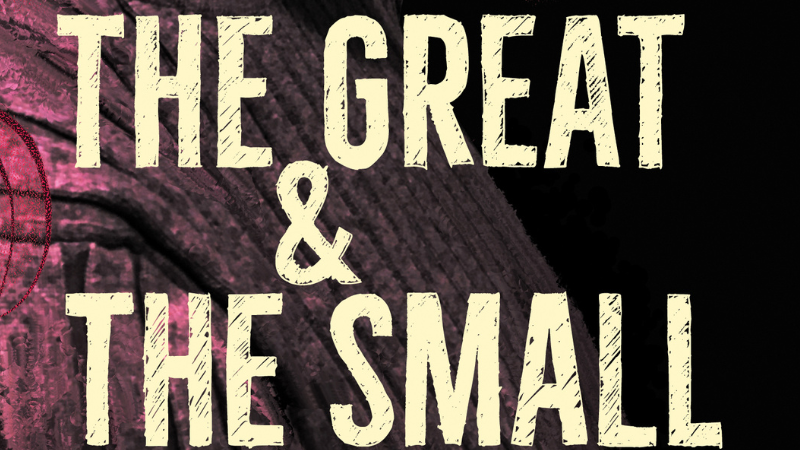 Bravery meets betrayal in this dystopian tale where a human and a rodent bridge their different worlds as an interspecies war rages, in the award-winning YA novel illustrated and written by A.T. Balsara. “The Great and The Small” (Common Deer Press, Sept 3, 2024) follows a young tormented teen who befriends a rebellious rat and the inexplicable way their lives intertwine in this dark yet hopeful story of resilience, acceptance, and strength.
Bravery meets betrayal in this dystopian tale where a human and a rodent bridge their different worlds as an interspecies war rages, in the award-winning YA novel illustrated and written by A.T. Balsara. “The Great and The Small” (Common Deer Press, Sept 3, 2024) follows a young tormented teen who befriends a rebellious rat and the inexplicable way their lives intertwine in this dark yet hopeful story of resilience, acceptance, and strength.
Filled with beautiful graphic illustrations, the Nautilus Book Award silver winner is being released with a new cover and expanded story that offers a deeper, nuanced exploration into themes of coping with buried sexual abuse, trauma, and PTSD that will resonate with teens.
Ananda is a troubled teen who feels like a misfit, and her unusual ability to connect with animals makes her feel like even more of an outsider. Still raw from her grandmother’s death, Ananda’s dreams are haunted by a long-buried memory that causes her to push people away. Fin is a Tunnel rat who lives in the dark places humans overlook or despise. Orphaned, he is the nephew of the Tunnel’s charismatic leader and will do anything to please his uncle. When Ananda protects Fin during a chance encounter in the market, neither can foresee how their lives will forever be inextricably linked, but as the Chairman launches a plague war against the humans, both Fin and Ananda wrestle with secrets so terrible that they threaten their very existence.
Told as mirroring narratives that reverberate with the effects of buried trauma, and informed by historical accounts of plague and dictatorship, this stunning tale examines what it takes to grasp for light in the darkness and survive the threats both beyond us and within us.
The Great and the Small
A.T. Balsara | 2nd edition Sept 3, 2024 | Common Deer Press
Contemporary YA fantasy
Paperback | 978-1-988761-10-7 | $15.99 USD, $19.99 CAD
Ebook | 978-1-988761-95-4 | $10.99 USD
 A.T. Balsara is an award-winning children’s and young adult author/illustrator, motivational speaker, and energy medicine practitioner. Her passion is to inspire joy through storytelling and energy healing, helping young people and adults to walk “the Hero’s Journey” in real life. She writes and illustrates for young children under her full name, Andrea Torrey Balsara, and for young adults under A.T. Balsara.
A.T. Balsara is an award-winning children’s and young adult author/illustrator, motivational speaker, and energy medicine practitioner. Her passion is to inspire joy through storytelling and energy healing, helping young people and adults to walk “the Hero’s Journey” in real life. She writes and illustrates for young children under her full name, Andrea Torrey Balsara, and for young adults under A.T. Balsara.
Andrea is also a painter, an avid amateur explorer of quantum physics, and a keen environmentalist. She advocates for the humane treatment of animals and regularly volunteers at a donkey sanctuary where she uses energy medicine to help previously neglected and abused animals regain their health and vitality.
To learn more about her and sign up for her newsletter, visit: www.torreybalsara.com
Follow A.T. Balsara on social media:
Facebook: @AndreaTorreyBalsara | Twitter: @torreybalsara | Instagram: @andreatorreybalsara
Praise and awards for the first edition of The Great and The Small
- 2020 Page Turner Book Awards, shortlisted; won the Spectrum Audiobook prize 2018 Nautilus Book Awards, Silver
- 2018 Literary Classics, Eloquent Quill Award (top honors); Golds in Upper MG Adventure category and Special Interest-Epic category
- 2018 ScreenCraft Cinematic Book Competition, Semi-Finalist
- 2018 Moonbeam Book Award, Silver
- 2018 Purple Dragonfly Award, Silver
- 2018 National Indie Excellence Awards, Finalist Spring
- 2018 Canadian Children’s Book Centre’s BEST BOOKS for Kids & Teens Magazine selection
“This YA book ‘The Great and The Small’ is George Orwell’s ‘Animal Farm’ and ‘1984’ meets Hemingway’s ‘For Whom the Bell Tolls’…”
-Richard M. Grove, publisher, editor, writer, poet laureate
“A. T. Balsara’s The Great and the Small is an irresistibly compelling graphic novel that weaves Gothic and Modern eras into a dark tapestry at times both tender and violent…It is the storyline that pulls you down the page with urgency, yet these pictures are so arrestingly beautiful, you simply find yourself stopping to luxuriate in them…In this age of intense scrutiny of the destructive nature of humankind towards the entire world, The Great and the Small is an enlightening parable that is as irresistible as it is timely.”
-Philip Roy, author
“Exploring the complex layers of the human (and animal) heart, and what it means to love and struggle with ties to family as well as the greater good, A.T. Balsara deftly weaves a tale that is compelling and thought-provoking. Asking the reader to understand how ignorance, misunderstanding, blind ideology, hatred, and betrayal can lead us only into the darkest abyss, The Great & the Small reminds us of the higher ideals that unite us all, whether great or small.”
-Leila Merl, poet and former high school teacher
“This gripping tale speaks volumes on many underlying themes which add greater depth and symbolism to an already powerful story. Highly recommended for home and school libraries, The Great & the Small has earned the Literary Classics Seal of Approval.”
-Literary Classics Review
In an interview, A.T. Balsara can discuss:
- Why she decided to revisit her YA book to include more of Ananda’s story
- Why she decided to write a story from two separate perspectives (one of a rat and one of a young girl) and the process of intertwining the two stories together
- How she approached writing a YA story after years of writing and illustrating children’s books
- How the character of Fin battles with his personal struggle with blind obedience
- How Balsara incorporates themes of racism, dictatorship, authoritarianism, and “the other” through the guise of a rat colony
- How Ananda’s story is a personal reflection of her own struggles with PTSD and sexual abuse
- How her work in energy healing has helped her overcome her personal trauma and how she uses to help others
An Interview with A.T. Balsara
1. Where did the inspiration for the story come from? And why did you want to write a story about rats?
There are two distinct and yet intertwining stories in The Great and The Small. Both the human girl Ananda’s story and Fin the rat’s story tell the story of being estranged from one’s true self, one because of buried trauma, and the other by his culture, in this case a rat colony’s culture that was based on the Stalinist era of the Soviet Union.
2. What is your creative process like when writing and illustrating your novels?
I suffer from a serious case of imposter syndrome, as many writers do, and so to get myself out of my head, I start with picking soundtracks that have the feeling and tone of the story I have brewing. I have soundtrack playlists for every project I work on. At the moment, I have 9 playlists on the go, for projects I’m either writing, illustrating or am stewing about. It’s a way of easing into the project, of sneaking in the backdoor, that puts my inner critic at ease. If a story is coming to me, ideas come fast– and can leave just as quickly. At those times, I keep pencil and paper handy, or my phone, and frantically jot down whatever notes or scene ideas come to me before they disappear into oblivion, and file them with the collection of jotted notes and reference photos I’ve kept for the project. That stewing/brewing process of gathering ideas often takes years. When a project rises to the top and feels ready to work with, I choose a song that fits the moment and play it on a loop, as loud as my poor dogs can stand. With my scraps of notes and photos spread around me, I start fleshing out characters, writing a rough outline of significant events in the book, and clarify the conclusion I want to reach. And then I “gird my loins” and dive into that dreaded first draft, which feels less like creative writing and more like drilling through rock (my head, in this case). For me, the joy comes in the rewrite. As the book takes shape under my hands, there are moments where scenes write themselves and the characters move and act of their own accord–and I’m writing with eyes half-closed, recording what I “see.” That’s the joy. That’s when all the drilling falls away and I feel like I’m flying. It’s addictive, joyful, and deeply satisfying.
3. You have two unusual storylines that interconnect in the novel (a story about a colony of rats and a teenage girl struggling from buried trauma). What are the overarching themes that connect these stories?
Both Fin and Ananda’s stories reflect the oppression of not knowing who you truly are. I have always loved the Hero’s Journey archetype and as I walked through my own “dark night of the soul,” I found that in those darkest times there was always a thin sliver of light. There was always something, some way forward, even when the way seemed impossible. We love reading about a character’s struggles and can see their heroism, but somehow we never frame our own struggles and cycles of growth in terms of the Hero’s Journey. Our instant-gratification culture is deathly afraid of pain, and of self-sacrifice, but if we walk the Hero’s Journey, and as we surrender illusion to seek truth, we find a return to our true self. It is a painful, and yet unspeakably joyous journey.
For Ananda, the buried abuse makes her doubt herself, veils her from who she truly is, and drives her to the edge of the abyss. For Fin, the environment of his home, tunnel culture, and the love he has for his uncle, blinds him to his uncle’s true nature and from truth. He finds himself doing acts of incredible cruelty in the name of the “common good,” and yet still tries to run and hide from what he’s become until finally he can’t anymore. In those moments of the story where Fin and Ananda interact, they help each other take another step towards the light and away from the darkness. Both must walk the Hero’s Journey to find their true selves.
4. The 1st edition won several awards, so why did you feel the need to rewrite the book and re-release it as a 2nd edition?
It became clear to me after the first edition was published in 2017, that Ananda’s story wasn’t finished. When I was given the opportunity to rewrite it by Common Deer Press, I was finally at a point where I could tell Ananda’s story and to explore those dark corners of my own experience through her eyes. It was a deeply painful, cathartic, and yet joyful experience. I loved being able to dive back into this world I had created, which I loved so much. Ananda’s character unfolded as I wrote and revised, until she became real to me. Through her, I saw my own struggles with new eyes, and gained compassion and understanding for my younger self. I hadn’t realized the compounding impact that buried memory has on a person and on their sense of self. I wanted to write about what it’s like to feel crazy, to know truth but doubt it, and to have the time bomb of suicide ideation ticking inside you. Many people have gone through what I have, and many are still stuck in the abyss. I want people to know that there is light after the darkness, and that although sorrows and pain carve furrows into you, as you heal, those furrows are filled with joy. There are gifts that are only revealed through trauma and deep suffering, like the jack pines whose cones only open in the fire. I want those who still suffer to know that there is not only hope, but there is joy if they keep walking.
Download press kit and photos

A former award-winning journalist with national exposure, Marissa now oversees the day-to-day operation of the Books Forward author branding and book marketing firm, along with our indie publishing support sister company Books Fluent.
Born and bred in Louisiana, currently living in New Orleans, she has lived and developed a strong base for our company and authors in Chicago and Nashville. Her journalism work has appeared in USA Today, National Geographic and other major publications. She is now interviewed by media on best practices for book marketing.


